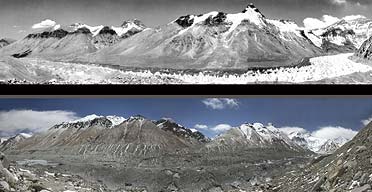
The Rongbuk glacier on the northern slopes of Everest in 1968 (above) and this year (below)
One of the world's most spectacular ice formations - the
towering serac forest near Mount Everest's base camp - is rapidly
shrinking as a result of global warming, Greenpeace said today.
Before and after photographs released by the environmental group show how the past 40 years of climate change are transforming the Himalayan landscape as ancient glaciers melt and retreat higher up the slopes.
The first photograph, taken in 1968, shows a long valley filled with white seracs, tilting pinnacles of ice as high as 20 metres, that form on Rongbuk glacier on the northern slopes of Everest. In the second photograph, taken this spring, the ice forest has virtually disappeared. The valley is a grey desert of rocks covering the angular surface of the glacier. The remaining seracs are barely visible on the right of the picture, where they have retreated far up the slopes of Mount Guangming.
"The demise of the ice towers is the most significant sign of global warming in the Himalayas," said Li Yan, a climate change campaigner who was on one of Greenpeace's two recent expeditions to the region. "But this is just one example of what is happening right across the Qinghai-Tibet plateau. All the glaciers are depleting, threatening the livelihoods of millions of people."
The implications are enormous. The plateau is referred to as the world's third pole because it contains the biggest fields of ice outside of the Arctic and Antarctic. Its glaciers are the source of Asia's biggest rivers - Yangtze, Yellow, Indus and Ganges - which provide water for more than a quarter of the planet's population.
International institutions have produced evidence that rising temperatures are decimating ice fields. Last month, a report by the UN's Intergovernmental Panel on Climate Change forecast that if current trends continue, 80% of Himalayan glaciers will be gone in 30 years.
Professor Liu Shiyin of the Lanzhou institute of glaciology said the main upstream impact of glacial melt was an increase in the risk of flooding. Downstream flows were also affected presenting an increased risk of water shortages .
Before and after photographs released by the environmental group show how the past 40 years of climate change are transforming the Himalayan landscape as ancient glaciers melt and retreat higher up the slopes.
The first photograph, taken in 1968, shows a long valley filled with white seracs, tilting pinnacles of ice as high as 20 metres, that form on Rongbuk glacier on the northern slopes of Everest. In the second photograph, taken this spring, the ice forest has virtually disappeared. The valley is a grey desert of rocks covering the angular surface of the glacier. The remaining seracs are barely visible on the right of the picture, where they have retreated far up the slopes of Mount Guangming.
"The demise of the ice towers is the most significant sign of global warming in the Himalayas," said Li Yan, a climate change campaigner who was on one of Greenpeace's two recent expeditions to the region. "But this is just one example of what is happening right across the Qinghai-Tibet plateau. All the glaciers are depleting, threatening the livelihoods of millions of people."
The implications are enormous. The plateau is referred to as the world's third pole because it contains the biggest fields of ice outside of the Arctic and Antarctic. Its glaciers are the source of Asia's biggest rivers - Yangtze, Yellow, Indus and Ganges - which provide water for more than a quarter of the planet's population.
International institutions have produced evidence that rising temperatures are decimating ice fields. Last month, a report by the UN's Intergovernmental Panel on Climate Change forecast that if current trends continue, 80% of Himalayan glaciers will be gone in 30 years.
Professor Liu Shiyin of the Lanzhou institute of glaciology said the main upstream impact of glacial melt was an increase in the risk of flooding. Downstream flows were also affected presenting an increased risk of water shortages .
No comments:
Post a Comment